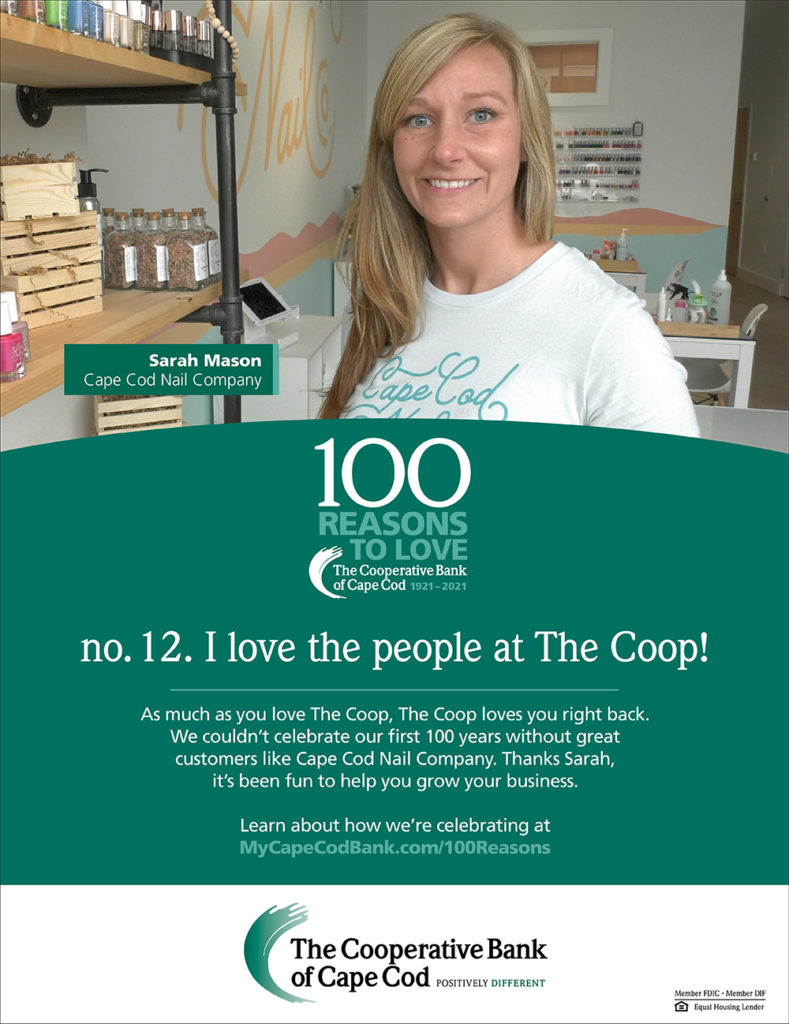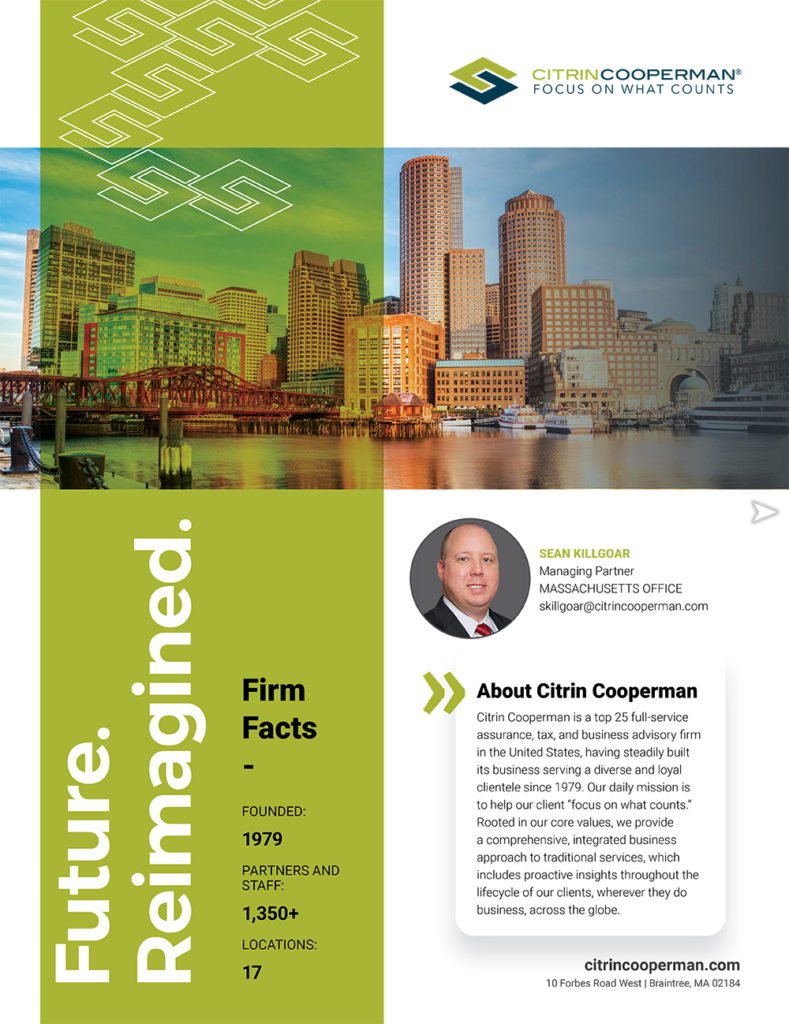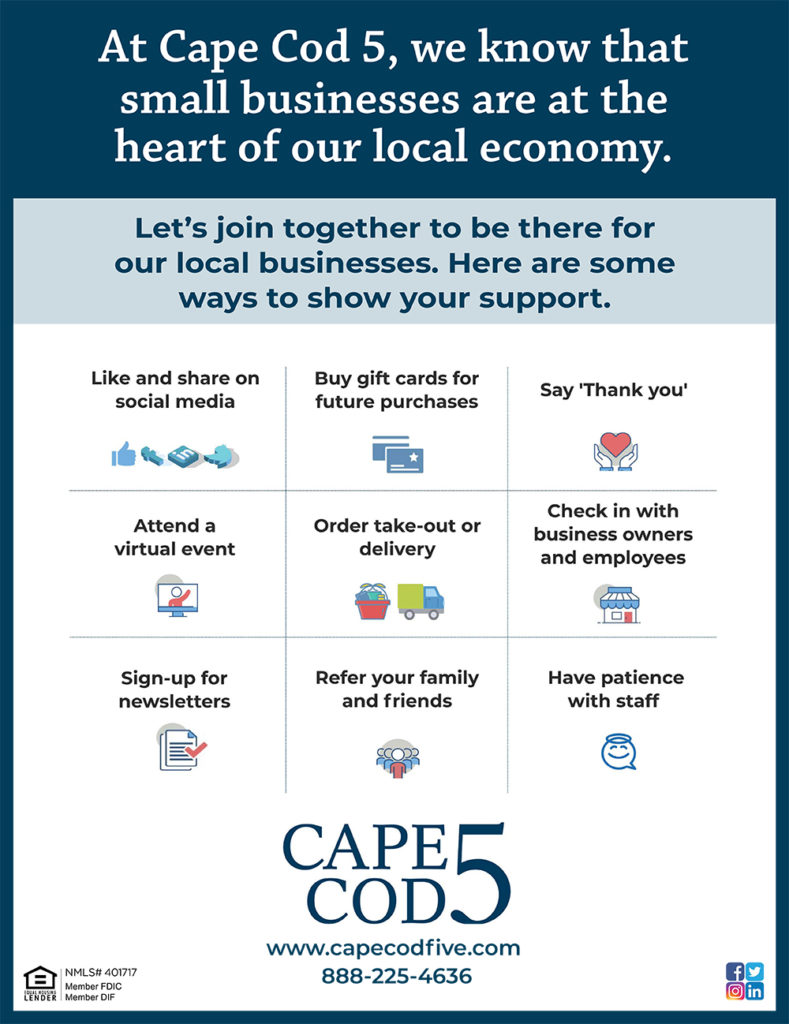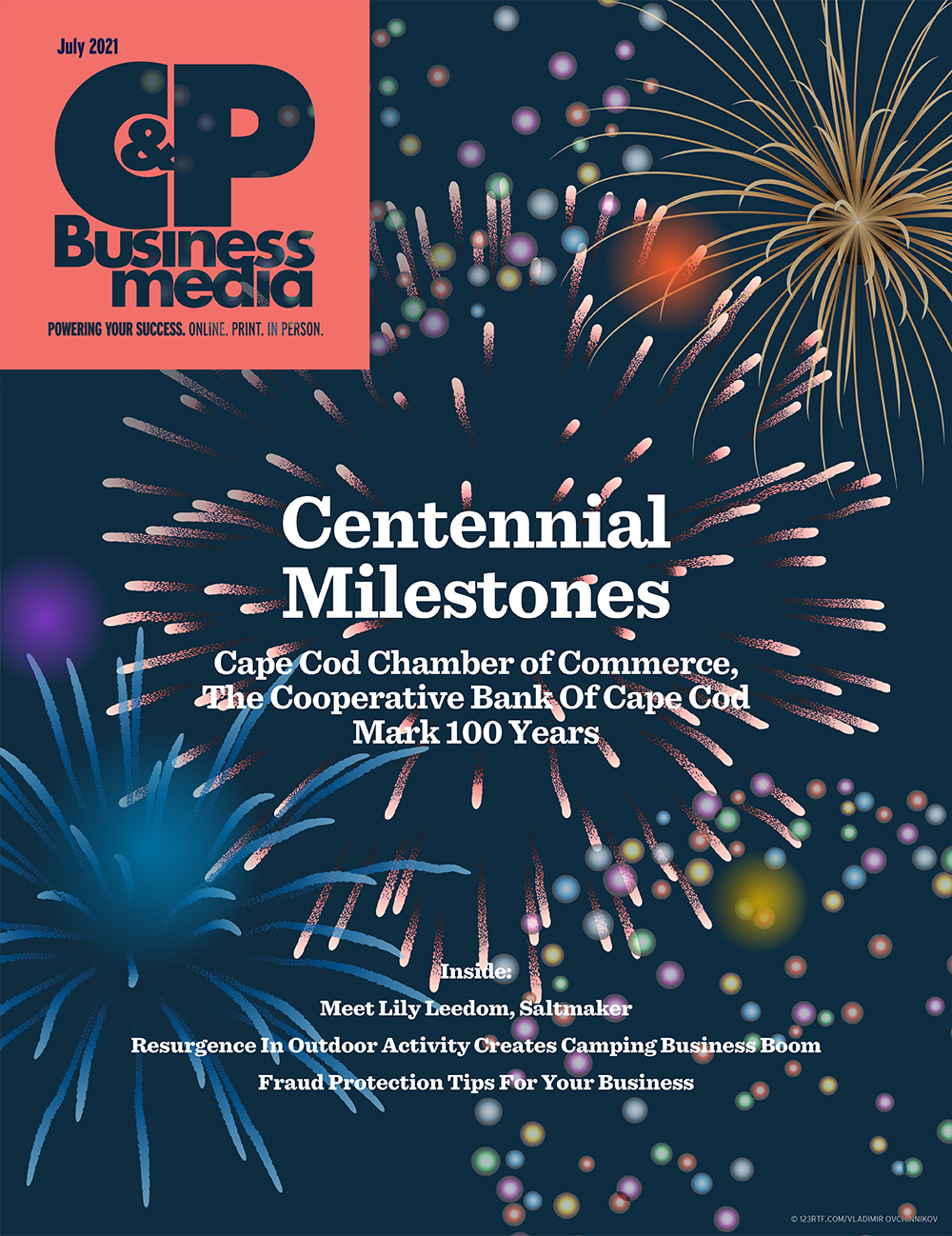
Centennial Milestones
One hundred years ago, Cape Cod was quite a different place when the Cape Cod Chamber was formed in March and Cape Cod Cooperative Bank (now The Cooperative Bank of Cape Cod) was chartered in July. Tourists were few and development was scarce. The state called Cape Cod a “backwater” of Massachusetts. Try to imagine the Cape without the canal bridges, which were not built until the 1930s. In this issue we celebrate the centennial anniversaries of two institutions that have been involved in shaping the Cape Cod of today. Both have served in advocacy roles: the chamber for promoting small businesses and protecting the Cape’s resources and character; the bank for fostering home ownership, assisting local businesses and supporting the community through philanthropic efforts. Both organizations played instrumental roles in keeping the Cape afloat during the recent pandemic. Also noteworthy: both the chamber and the bank are led by two incredible women, the chamber’s Wendy Northcross and The Coop’s Lisa Oliver, both of whom were the first female leaders at their respective organizations. Bravo!
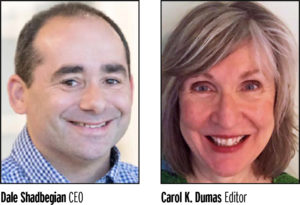

BY THE NUMBERS – Camping Is Big Business Now More Than Ever
ANYTHING BUT ORDINARY – Lily Leedom, Saltmaker
SPOTLIGHT ON GIVING – Habitate For Humanity Of Cape Cod Champ Homes
MENTORING – Customer Service: The Foundation For Brand Loyalty
MARKETING – Survey Says: People Like Email Afterall
FEATURE STORY – Resurgence In Outdoor Activity Creates Camping Business Boom
BUSINESS TOOLBOX – Security: Fraud Protection For Your Business
BUSINESS TOOLBOX – Human Resources: Creating An Experience For Your Employees
BY THE NUMBERS

TIDBITS
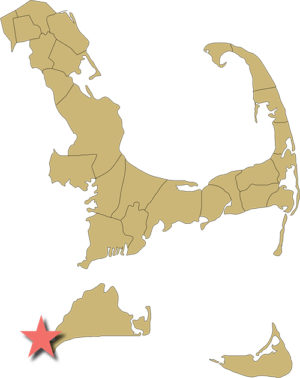 Around the Region
Around the Region
Town of Aquinnah
SOURCE: CENSUSREPORTER.ORG,
CITY-DATA.COM
Form of Government:
Open Town Meeting
Incorporated: 1870
Demographics:
Total population ……………. 531
Female: ………………………….49%
Male: ……………………………… 51%
White: ………………………….. 56%
Black: ………………………………. 0%
Asian: …………………………………………………………………………………………………. 0%
Native American……………………………………………………………………………. 22%
Persons reporting two or more races: ……………………………………….. 11%
Hispanic or Latino: ………………………………………………………………………… 11%
Total housing units: ………………………………………………………………………. 498
Family households: ………………………………………………………………………… 176
Average household size: …………………………………………………………………. 3.0
Median Earnings:
Median household income: …………………………………………………. $95,625
Per capita income: ………………………………………………………………….. $51,537
Mean travel time to work: …………………………………………. 22.4 minutes
Educational Attainment (age 25+):
High school graduate: ………………………………………………………………… 97.7%
Some college…………………………………………………………………………………… 27%
Bachelor’s degree: ……………………………………………………………………….49.9%
Post-graduate degree: …………………………………………………………………… 18%
 Chatham Among Top Ports Facing Gentrification Pressure
Chatham Among Top Ports Facing Gentrification Pressure
A new study shows Chatham is one of the top three fishing ports in the Northeast facing severe gentrification pressure — likely not a surprise. “People feel like the story map (the way the findings were presented) reflects their lived reality,” said Matthew Cutler, a social scientist with NOAA’s Northeast Fisheries Science Center who worked on the project. Cutler, working with Rose Jimenez at the NOAA Center for Earth System Sciences and Remote Sensing Technology, said communities chosen to measure gentrification pressure all showed high fishing engagement scores – which includes the value of landings and number of permits in town – from 2009 to 2018. First on the list was Barnegat Light, New Jersey. Chatham was right behind Montauk, New York. All three are ports with fishing ties that reach back to the 1700s, but they are also blessed with natural amenities, have a lot of wealth, and are hot vacation spots. Chatham, more so than many of the other 28 communities measured, is “highly reliant” on fisheries, the study said, and its housing disruption is “often linked to an out-migration of younger residents and displacement of less affluent residents.” Cutler said other fishing communities on the Cape, such as Provincetown, also face severe gentrification pressures. But those communities may not have been on the list because landings in one of the years in the data set was low or not attributed to that port. “I want to re-emphasize that these are indicators, they aren’t the definitive answer,” Cutler said.
SOURCE: WWW.CAPECODFISHERMEN.ORG
New Waypoints Trail Unveiled By Cape Cod Chamber
Cape Cod Chamber of Commerce has announced a new cultural attraction, the Waypoints Trail, a unique blend of interpretive structures integrated with a mobile-ready web experience, eventually spanning more than 30 locations on Cape Cod, Nantucket and Martha’s Vineyard. Inspired by the lifesaving shacks that once dotted the Cape coastline providing refuge for shipwrecked sailors, the Waypoints are a series of modular cubes, panels and posts that allow for contemplation, education and investigation about the region’s past, present and 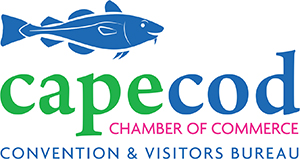 especially, the future. Each Waypoint features one or more viewfinders that focuses attention on a particular subject and invites further exploration of a network of other markers, surprising artifacts, and new points of interest. Each Waypoint encourages further exploration through the mobile web site, as well as an invitation to share experiences via social media. Waypoints are designed for all ages but with particular emphasis on educating young people about the special relationship with the region’s waters, from working waterfronts to aquaculture and commercial fishing, marine technology and science, transportation and recreation. Explore Waypoints in Hyannis, Bourne, Brewster, Chatham, Falmouth, Nantucket, Provincetown, Sandwich, Tisbury, Vineyard Haven and Yarmouth. More sites will be added in the future. Waypoints are part of the Cape Cod Chamber of Commerce’s Expedition Blue project, an initiative to build a sense of pride and identity in the water economy and to encourage responsible blue economy entrepreneurship and employment. Waypoints was funded by a grant from the Seaport Economic Council.
especially, the future. Each Waypoint features one or more viewfinders that focuses attention on a particular subject and invites further exploration of a network of other markers, surprising artifacts, and new points of interest. Each Waypoint encourages further exploration through the mobile web site, as well as an invitation to share experiences via social media. Waypoints are designed for all ages but with particular emphasis on educating young people about the special relationship with the region’s waters, from working waterfronts to aquaculture and commercial fishing, marine technology and science, transportation and recreation. Explore Waypoints in Hyannis, Bourne, Brewster, Chatham, Falmouth, Nantucket, Provincetown, Sandwich, Tisbury, Vineyard Haven and Yarmouth. More sites will be added in the future. Waypoints are part of the Cape Cod Chamber of Commerce’s Expedition Blue project, an initiative to build a sense of pride and identity in the water economy and to encourage responsible blue economy entrepreneurship and employment. Waypoints was funded by a grant from the Seaport Economic Council.
SOURCE: EXPEDITIONBLUE.ORG
ANYTHING BUT ORDINARY
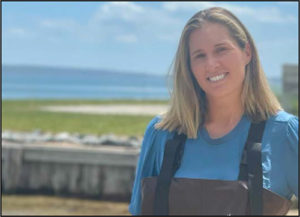
Lily Leedom
Saltmaker SalterieOne
403 Washington St.
Duxbury
781-257-6044
https://salterieone.com/
How did you start in this business?
For me, the idea for SalterieOne started with realizing that sea salt was one element of the food industry that had not yet been transformed to meet consumers’ desire for local, healthy, natural, handcrafted ingredients. So many other categories, such as chocolate, tea, honey and many more, had already evolved with artisanal, small-batch choices from local makers. Then, one summer while I was swimming at my local beach in Duxbury, I wondered whether I could make sea salt from the waters right here in my own backyard. So, I essentially started out testing how to make sea salt in my own kitchen, bringing the salt water home in buckets. That’s when my idea became a reality.
Describe what you do.
At SalterieOne, it’s our mission to enrich people’s cooking, eating and life experiences by hand-harvesting pure sea salt — the most ancient, essential mineral — from the fresh waters of Duxbury Bay. We delicately nurture our Classic Sea Salt straight from the bay. We offer it in its purest form and as part of our custom-made seasoning blends. We are excited to share that we recently opened our showroom, where we host a fun Sea Salt Tasting Experience and other special events. It’s located on the same campus as Island Creek Oyster Farm.
What is so special about the salts you make?
SalterieOne Classic Sea Salt is made by slow-simmering pure sea water and filtering it down to less than 5 microns. Our salt harvesters then carefully nurture it into flakes. We have created this special process to yield delicate, feathery flakes that pinch easily and melt on your tongue. Our sea salt is free of additives and full of flavor, offering a vibrant, fresh taste to any dish.
What are your products?
Our products include SalterieOne Classic Sea Salt; two original seasoning blends, the Seasonal Collection which highlights the flavors of winter, spring, summer and fall, and the Compass Collection inspired by culinary trends across the globe, featuring two blends so far, North and South. We also have gifts, including a seasonal sea salt sampler, a seasonal salt subscription set, unique saltware and more.
What do you like about owning your own business?
My favorite thing about owning my business is the connections. I have made so many wonderful connections with people through our shared love of good food, a healthy lifestyle and a desire to create something special. I also love the connection to nature and the sea. We have a beautiful water view from our salt workshop and I am thankful every day for the gift of saltwater and fresh salty air. The “One” in SalterieOne embodies the spirit of connectivity to one another and to nature. There are so many things I like about owning this business!
NEWS & MOVES
RogersGray has announced it has entered into a partnership agreement with Baldwin Risk Partners (BRP Group Inc.) effective July 1, 2021. The move is a tremendous opportunity for the local insurance group that will now have national scale and access to more carriers as RogersGray becomes the platform agency for BRP New England, meaning that any future growth or acquisitions will all be folded into the RogersGray brand. RogersGray brand, offices and more than 200 employees will remain and the company expects to be adding more positions, said Mike Robinson, RogersGray chairman and co-president, BRP New England region. “We’re partnering with a firm that gives us scale and more tools in our toolbox to help clients, and create opportunities for the colleagues that work at RogersGray,” said David Robinson, RogersGray president and chief executive officer, who will become co-president, New England Region. “We have worked extremely hard to ensure there are no downsides for our team or clients during this entire process.” RogersGray has been named one of Insurance Journal’s Top 100 independent property/casualty agencies in the U.S. and provides risk solutions to commercial clients across a broad range of industries, with particular strengths in real estate, construction and utilities, and brings to BRP Group an attractive coastal personal lines footprint. BRP Group, Inc. (NASDAQ: BRP) is an independent insurance distribution firm delivering tailored insurance and risk management insights and solutions. BRP Group represents over 600,000 clients across the United States and internationally.
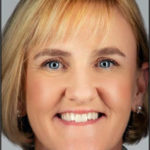 Kim Dee, executive vice president, customer transformation director, has been promoted to head of Retail Banking at Citizens. In her new role, she will be managing a retail organization of 5,000 colleagues and 1,000 retail branch locations. She has held a number of roles during her career at Citizens including executive vice president/sales strategy and distribution, head of sales for Business Banking, and product management and retail director for the Greater Boston and New England South regions. In her most recent role as customer transformation director for Core Banking, Dee implemented a large-scale, complex change agenda in the retail branch network. The program focused on digital migration, relationship and advice-based solutions, enhancements to colleague development, and streamlining retail operation processes and procedures. A resident of Braintree, Dee is a graduate of Boston College Carroll School of Management where she graduated with a degree in Finance and Marketing.
Kim Dee, executive vice president, customer transformation director, has been promoted to head of Retail Banking at Citizens. In her new role, she will be managing a retail organization of 5,000 colleagues and 1,000 retail branch locations. She has held a number of roles during her career at Citizens including executive vice president/sales strategy and distribution, head of sales for Business Banking, and product management and retail director for the Greater Boston and New England South regions. In her most recent role as customer transformation director for Core Banking, Dee implemented a large-scale, complex change agenda in the retail branch network. The program focused on digital migration, relationship and advice-based solutions, enhancements to colleague development, and streamlining retail operation processes and procedures. A resident of Braintree, Dee is a graduate of Boston College Carroll School of Management where she graduated with a degree in Finance and Marketing.
NONPROFIT NEWS


Chitkara, Mebane
Join CHC Board Of Directors
Community Health Center of Cape Cod announces the addition of two new members to their board of directors. Bhawana Chitkara, of Mashpee, is the founder and owner of Fabvilla, a lifestyle boutique in Mashpee Commons. She received her bachelor of arts in Sociology from the University of Delhi in India and has more than 20 years of professional management experience. Prior to owning her own business, she was a vice president, branch manager at Eastern Bank. She also worked at RBS Citizens Financial Group as assistant vice president, branch manager. The Rev. Will Mebane, Jr. serves as the rector of St. Barnabas Memorial Episcopal Church in Falmouth and is a member of the faculty for the Episcopal Preaching Foundation. Prior to his enrollment in seminary; he held executive management positions with broadcast outlets in North Carolina, New York and Connecticut where he founded a management, media, and marketing consulting firm.
Mebane, a Falmouth resident, holds a bachelor of arts degree in Radio, Television, and Motion Pictures from the University of North Carolina at Chapel Hill. He entered Yale Divinity School just before his 50th birthday and earned the master of divinity degree along with an award for excellence in preaching from Yale University.



Southcoast Community Foundation
Announces Team Additions, Promotion
The SouthCoast Community Foundation has announced the hiring of Werlaine Badio as programs officer, supporting arts and culture, education, and economic development initiatives, and Nhamaa Cortes as accounting clerk. Additionally, Adrianna Heard has been promoted from development systems administrator to donor services associate. Badio grew up in Brockton, graduated from UMass Dartmouth, and is now living in Fall River. Heard was born and raised in New Bedford and graduated in 2020 from Westfield State University. Cortes was born and raised in New Bedford and graduated this spring from Bridgewater State University with a degree in Accounting and Finance.
Old Colony Elder Services, a nonprofit organization serving older adults and individuals with disabilities throughout greater Plymouth County, has promoted Anna M. Dee to chief operating officer. For two years prior to her promotion, Dee held the position of business improvement director at OCES. In her new role Dee will oversee the business operations of OCES, establishing goals and priorities for the agency. Dee’s previous experience includes 12 years at State Street Corporation, Boston, where she held numerous positions, including three years as assistant vice president, project manager focusing on corporate initiatives.

NeighborWorks® Housing Solutions’ Associate Real Estate Development Director Noelle Humphries recently completed the 2020-2021 Community Development Mentoring Program, cosponsored by the Mel King Institute for Community Building, the Massachusetts Association of Community Development Corporations and the Citizens’ Housing and Planning Association. Humphries finished the nine-month program as a mentor focused on real estate development earlier this spring. The Mentoring Program is designed to promote and support a culture of learning and mentoring within the community development field. The program enhances the preparation of mid- to senior-level professionals of color who demonstrate leadership potential, for advancement and growth into positions of leadership and authority, by facilitating effective and meaningful relationships between and among community development professionals. Humphries has more than 20 years of experience in housing development, and specifically with multi-family housing development. She has been with NHS for nearly two years, and has played a key role in the development of multiple affordable housing developments.
Atlantic White Shark Conservancy, a Chatham-based nonprofit committed to funding scientific research, improving public safety and educating the community about white sharks, has launched “Gills Talk,” a podcast featuring interviews with women working in shark and ocean science. “Gills Talk” is a branch of the Conservancy’s Gills Club. With the motto “Smart About Sharks,” The Gills Club is the Atlantic White Shark Conservancy’s STEM-based education initiative dedicated to connecting youth with female scientists from around the world, sharing knowledge and inspiring the next generation of shark and ocean advocates and scientists. “Gills Talk” is a free podcast available on the Gills Club App and various streaming platforms, including Spotify, Apple Podcasts, Breaker, and Google Podcasts. Episodes will be released every other Monday and can be found using the search terms “Gills Talk” on the podcast platform of choice.
Road to Responsibility, a nonprofit organization supporting individuals with intellectual and developmental disabilities, is putting the finishing touches on a “smart home” at one of their group homes in Norwell serving people with complex needs, where assistive technology will be implemented to promote client independence. The home will be run primarily through Alexa products, including window blinds, lights, mirrors, appliances, televisions, robot vacuums, doorbell, automatic trash containers, iPads, and thermostat. Other mechanisms controlled by assistive technology will include mattress pads that monitor sleep, pens that read text aloud, a microwave braille overlay and a number of entertainment-related devices. This creative approach to support residential clients was made possible through funding by the Pilgrim Bank Foundation, the HarborOne Foundation and The Doug Flutie Jr. Foundation for Autism.

The Cook Family Charitable Fund has appointed Peter Thompson to the organization’s board of directors. The mission of the nonprofit organization, founded in 2006, is to improve the lives of those struggling from substance use disorder, cancer and intellectual disabilities by helping to eliminate financial barriers that may impact their journeys. Thompson, a Braintree businessman and resident and his wife, Heather, lost their son Ryan to substance use disorder 10 years ago. Over the years, the Thompson Family has been a key sponsor of the Gavin Foundation, the Cook Family Charitable Fund and One Life at a Time. In partnership with the Cook Family Charitable Fund, the family has established a scholarship fund to honor Ryan, with a focus on families and individuals who are suffering from substance use disorder.
SPOTLIGHT ON GIVING
 Habitat for Humanity of Cape Cod
Habitat for Humanity of Cape Cod
411 Main Street, Yarmouth Port, MA 02675
508-362-3559
www.habitatcapecod.org
office@habitatcapecod.org
Stats
Total number of employees: 28
Annual revenues: $3,382,377
Year established: 1988
Mission
Habitat for Humanity of Cape Cod partners with families in need of an affordable home to build one of their own; fostering stability, self-reliance and a strong sense of community.
Geographic Area
Cape Cod
Funding

Leadership
Wendy Cullinan
EXECUTIVE DIRECTOR

 Champ Homes
Champ Homes
82 School Street, Hyannis, MA 02601
508-771-0885
info@champhomes.org
www.champhomes.org
Stats
Total number of employees: 6 full time; 2 part time.
Annual revenues: $600,000
Year established: 1991
Mission
Champ Homes – Places of Hope, Built on Faith It is our ongoing mission to provide transitional housing to adults on Cape Cod who are homeless or near homeless in a safe, compassionate, respectful environment, where we instill confidence and hope through providing life skills, mentoring, vocational opportunities, and self-advocacy, while building faith in one’s God, one’s self, in others and beyond.
Leadership
Adam Burnett ED
Mark Boudreau BOARD CHAIR
2021 Goals
As we celebrate our 30th anniversary we look to build capacity and continue strengthening relationships with our community partners that serve as incredible resources for our Champ
Homes’ participants.
Volunteer Opportunities
We are presently limiting volunteer opportunities in an attempt
to do our part in reducing the spread of COVID-19. As conditions change, please feel free to call us and ask how you can get
involved.
Economic Development
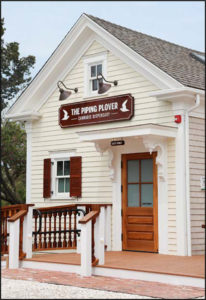 The Piping Plover, a locallyowned, adult-use, recreational cannabis dispensary, opened May 22 at 10 Main St. in Wellfleet. The owners are Zachary Ment, founder and CEO, and Michael Drayer, director of Retail Operations, who worked closely with the Town of Wellfleet to bring their vision to fruition. The team broke ground in fall 2019 and began working with local contractors and craftsmen on the historic restoration of 10 Main St. in Wellfleet, known as “The Old Bank.” “We designed and constructed our building with our town, employees, visitors, and the environment in mind,” said Ment. “The building is powered 100 percent by our own solar panels, and reclaimed materials were used whenever possible. We have done our best to make sure there are ample parking spaces, clear directions for in-and-out, space to bring customers in from the outside through our deck and wide open spaces within the store for a safe and comfortable experience unlike any other.” To learn more about the Piping Plover, visit pipingplover.co.
The Piping Plover, a locallyowned, adult-use, recreational cannabis dispensary, opened May 22 at 10 Main St. in Wellfleet. The owners are Zachary Ment, founder and CEO, and Michael Drayer, director of Retail Operations, who worked closely with the Town of Wellfleet to bring their vision to fruition. The team broke ground in fall 2019 and began working with local contractors and craftsmen on the historic restoration of 10 Main St. in Wellfleet, known as “The Old Bank.” “We designed and constructed our building with our town, employees, visitors, and the environment in mind,” said Ment. “The building is powered 100 percent by our own solar panels, and reclaimed materials were used whenever possible. We have done our best to make sure there are ample parking spaces, clear directions for in-and-out, space to bring customers in from the outside through our deck and wide open spaces within the store for a safe and comfortable experience unlike any other.” To learn more about the Piping Plover, visit pipingplover.co.
 Cumberland Farms has opened its newly renovated store at 400 East Falmouth Highway in East Falmouth. Spanning more than 4,300 square feet, the retailer will offer six gas fueling stations across three islands, 24 parking spots, and curbside pick-up/order ahead capabilities available with the SmartPay Rewards app. Among an extensive variety of food and beverage items, this Cumberland Farms location will feature its Farmhouse Fresh To Go™ concept which includes fresh, handcrafted espresso beverages and a wide selection of breakfast and lunch sandwiches made daily in its own kitchen. In addition, Cumberland Farms Farmhouse line of baked goods, ice cream and snacks will be available.
Cumberland Farms has opened its newly renovated store at 400 East Falmouth Highway in East Falmouth. Spanning more than 4,300 square feet, the retailer will offer six gas fueling stations across three islands, 24 parking spots, and curbside pick-up/order ahead capabilities available with the SmartPay Rewards app. Among an extensive variety of food and beverage items, this Cumberland Farms location will feature its Farmhouse Fresh To Go™ concept which includes fresh, handcrafted espresso beverages and a wide selection of breakfast and lunch sandwiches made daily in its own kitchen. In addition, Cumberland Farms Farmhouse line of baked goods, ice cream and snacks will be available.
 Martha’s Vineyard Bank officially cuts the ribbon at its newest location on the Village Green at 84 Main St. in Falmouth. Back row, from left: James M. Anthony, president and CEO of Martha’s Vineyard Bank; Bruce MacKilligan, former president of Falmouth National Bank, Kenneth Galley, trustee, and Stever Aubrey, trustee. Front row, from left: Ann Tyra, trustee;Julian Suso, Falmouth Town Manager; Michael Kasparian, CEO Falmouth Chamber of Commerce; Frank Fenner, chairman and trustee; Donna Cummens, trustee, and Alison Shaw, trustee.
Martha’s Vineyard Bank officially cuts the ribbon at its newest location on the Village Green at 84 Main St. in Falmouth. Back row, from left: James M. Anthony, president and CEO of Martha’s Vineyard Bank; Bruce MacKilligan, former president of Falmouth National Bank, Kenneth Galley, trustee, and Stever Aubrey, trustee. Front row, from left: Ann Tyra, trustee;Julian Suso, Falmouth Town Manager; Michael Kasparian, CEO Falmouth Chamber of Commerce; Frank Fenner, chairman and trustee; Donna Cummens, trustee, and Alison Shaw, trustee.
Martha’s Vineyard Bank Opens
New Falmouth Branch
Martha’s Vineyard Bank officially opened its newest location on the Village Green in Falmouth at 84 Main St. in an historic building that has been a banking site for more than 200 years. “We look forward to sharing a unique approach to banking that combines personal service, a proactive consultative approach, and local decision-making with all of the conveniences of modern technology,” said Teri Ferreira-Keyes, Falmouth Regional branch manager for Martha’s Vineyard Bank. Renovations began in January 2021 with the goal of preserving as many historical components as possible while adding technology and innovation to meet customer needs. Phase Two is expected to begin this fall. The project architect is Joanne Gosser of Synergy MV. Martha’s Vineyard Bank is one of the first banks on Cape Cod and the Islands to utilize Interactive Teller Machines, where customers drive up, touch a screen, and a Martha’s Vineyard Banker assists them. The ITM uses a high-definition video chat to connect customers with full-service tellers and can help with cash and check deposits, loan payments, transfers to and from accounts, and many other transactions. For more information visit local.mvbank.com
MENTORING
By Marc Goldberg
If you want loyalty to your brand, creating a customer service culture is the foundation. This is accomplished by always making your customer come first. It is not about you and your products/services, it is about the needs, wants and desires that your customers require. It is finding out why they are seeking you out for a solution and then focusing on delivering a gain that will satisfy their pain. Buyers reach out to you to deliver solutions to their issues. If you focus on them, they see your mission is delivering value. If you can make your communications personal you are making them feel valuable. The interaction is not transactional, but relational. It is not a buyer entering your store, seeking a certain size nut and bolt to repair a screen door, paying, then leaving. It is you creating a dialogue about the door and the issues that caused the need for a new nut and bolt to understand their need and addressing what else might be involved in this issue. When a seller shows interest beyond the immediate need, they are creating a relationship that will form the foundation for a return engagement to meet the next need. If you can exceed the buyer’s expectation then you are checking off a box in their mental checklist of why they should continue to do business with you. The lawn is mowed, the hedges are trimmed and the landscaper notes that there are weeds popping up in one of the yard’s gardens and addresses their removal. This is done without charge. You have just exceeded their expectations and created value in the relationship. When the contracted tasks are completed and you ask the client what else they may need to have done, you are creating a relationship vs. showing up, doing the work, then leaving without checking in with the client. When you complete the installation of a new bulkhead, sending a handwritten thank-you note exceeds expectations. Customer service entails engendering trust, the trust that you will do what you promise in your proposal; doing what you promised by arriving on the day and time agreed upon. It means giving as early notice as possible if circumstances beyond your control require rescheduling. Not showing up does nothing but reduces trust and disappoints the buyer. Trust starts with connecting. Connecting means talking with, not at your customer. It’s understanding what drives their buying decisions so you can get one step closer every time you communicate. Having an understanding of their buying motivation keeps them engaged, buying again and referring you to others. As sellers and providers of customer service we have to keep in mind that buyers’ needs are currently being met by someone else. They are having their autos repaired, houses painted, lawns mowed, or newspapers delivered by another seller. In order 
“When a seller shows interest beyond the immediate need, they are creating a relationship that will form the foundation for a return engagement to meet the next need.”
for you to replace them, you have to have a differentiator. That difference might be how to treat your buyers, how you create “fanatic fans” for your brand. It is making customer service everyone’s job. As the owner or manager of a business, make customer service personal. Engage personally with customers to understand how they feel about the work you do, the services you perform and take either corrective action or improve your interactions to keep them buying from you. The way you get the best information is to ask. Ask them how you are doing, how you are satisfying their needs, wants and desires. Ask them how you can improve your service. Ask them what else you can do for them. Customer service is all about them, not you.
Marc L. Goldberg is a Certified Mentor at SCORE Cape Cod and the Islands. For free and confidential mentoring, contact SCORE Cape Cod and the Islands, www.capecod.score.org, capecodscore@verizon.net, 508/775-4884.
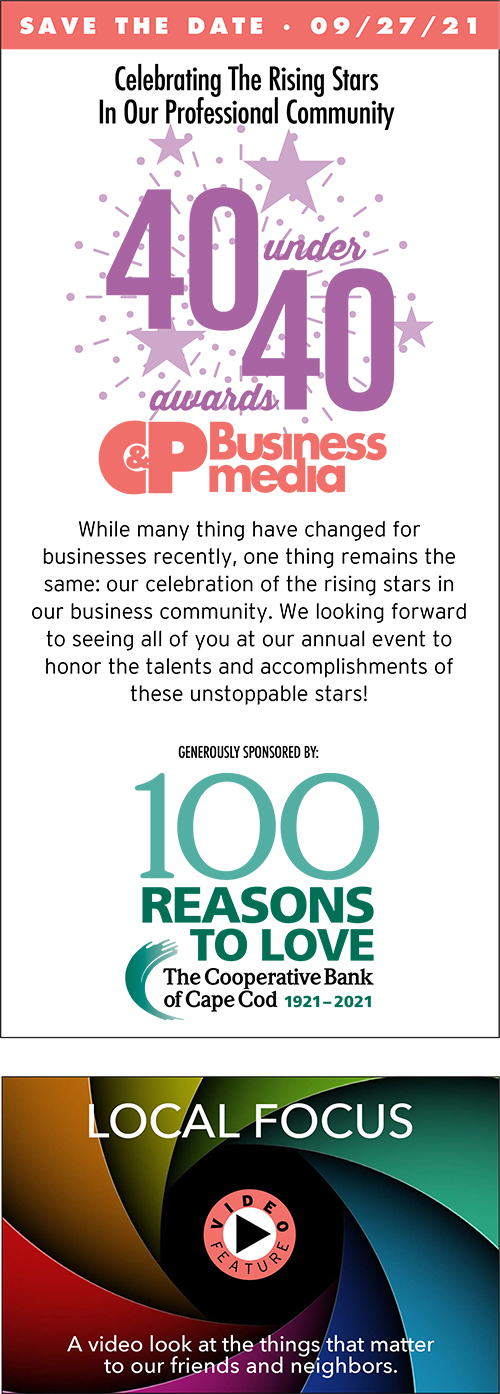
Marketing
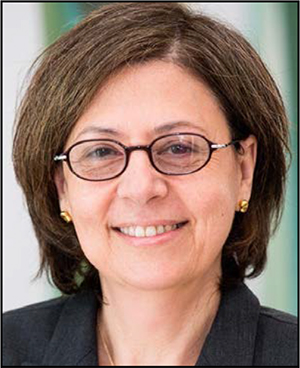 By Robbin Orbison
By Robbin Orbison
I am an email maven. I admit it. I love email. I think it is one of the greatest things ever invented. So I am naturally amazed at how often I hear people disparaging it. People say they hate email, don’t want any more email, get angry at email, feel overwhelmed by email, don’t come near me with email. Managing email comes very easy to me. But I’m a fast typist, so I can whisk through replies, archiving, unsubscribing or whatever, very quickly and easily. And my theory has always been that the anti-email people feel that way because they are not good typists. (Oddly, I owe my typing skills to something I thought was sexist and offensive at the time – the practice of forcing girls in high school to take typing lessons in I-won’t-say-what-decade. Who knew it would turn out to be so useful!) Anyway, I set out to prove the typing theory and discovered I was wrong not only about the typing, but about the sentiments of the majority in general. I sent a survey to about a thousand people of varied demographics and got 68 responses.
The Results
Question 1 – How do you feel about email?
While only 10 percent said they loved email like me, over 85 percent either liked it or were at least at peace with it; 12 percent said they tolerated it, but only 3 percent really despised it.
Question 2 – What do you like about email?
This was a “check all that apply” question, and the most checked answers included the freedom to send and reply on one’s own schedule, being able to share attachments and having a written record of communication. I gave people a choice to check “I don’t like anything about email” and it got ZERO responses.
Question 3 – What do you dislike about email?
The surprising most checked answer to this was “I dislike that people use email to avoid live interaction.” Despite my affection for email I have noted on many occasions that it is a passiveaggressive’s dream come true and certainly can be used to duck and shirk. Glad so many people are onto those tactics. The only other answer that came close was “Other,” which had a variety of write-in comments, the majority of which had to do with dislike of too many marketing emails. I found this surprising because these are the easiest ones to deal with – you either delete them, mark them as spam or unsubscribe.
Question 4 – How would you describe your proficiency at managing email?
Fifty-one percent said they are good at it although they consider it a chore; 28 percent considered themselves expert. Only two people admitted to being overwhelmed by managing email.

“I think email is one of the greatest things ever invented. So I am naturally amazed at how often I hear people disparaging it.”
Question 5 – Which of these things might make you feel better about email?
Another surprise. The most checked answer to this was “Nothing, I already like it!” But behind that came wishing for greater proficiency with email application features and help with filtering and controlling spam. Lastly, we asked “What else would you like to say about email?” We had 27 responses, most of them reiterating points already made. I liked one particular comment – that the respondent had been nicknamed “Ms. Email” – good for you Ms. Email! There were a few email fans who made a point of saying they hated talking on the phone and there were some strong Outlook vs. Gmail opinions. Fortunately, one person suggested that email should be voice activated to require less typing, so thanks to that person for not making my original thesis 100 percent wrong.
Key Takeaways
- The anti-email people are more vocal about their feelings but the quieter majority are mostly email fans.
- Pretty much all the benefits you can think of about email are appreciated by most people in a fairly evenly distributed way.
- The biggest irritants of email have to do with lack of proficiency with email applications and too much spam
So, this exercise cries out for a followup article on email application usage and spam management. Stay tuned!
Robbin Orbison is founder and president of CapeSpace, shared workspace centers located in Hyannis and Mashpee. She can be reached at robbin@capespace.com
Feature Story
By Ann Luongo
Packing up the family and heading off to the great outdoors has become all the rage since the pandemic hit. In fact, compared to 2019, the proportion of first-time campers across the U.S has grown five-fold, while the number of households that own RVs has grown by 2.6 million, according to the latest research from Kampgrounds of America’s annual North American Camping Report. While tenting is still popular, having a self-contained recreational vehicle is, by far, more convenient, particularly for families. In fact, RV sales have skyrocketed this year alone. People want that great outdoor experience, but also desire their own bathrooms with showers, indoor cooking areas and, of course, heat and air conditioning. On Cape Cod and Plymouth County, campgrounds large and small abound, with amenities including fishing areas, ponds and pools, playgrounds, coffee shops, mini markets, bath houses, kayak and boat rentals, and more. Or, if you really want to get away from it all, you can rough it in almost total privacy at state parks. In Brewster, Nickerson State Park is one of the most popular campgrounds around. The campsites there book up quickly each year, often selling out for the entire summer. Right now, it is close to being fully booked for the months of July and August, according to the state Department of Conservation and Recreation’s Press Secretary Olivia Dorrance, who adds there are some reservations still available for September and October. “As of June 10, 2021, there are 7,845 active reservations at Nickerson State Park for the camping season,” Dorrance said.m “During the 2020 camping season, there were 5,710 in a shortened season with fewer campsites available. During the 2019 camping season, Nickerson State Park saw 11,551 reservations. The breakdown of reservations is 5,672 tent reservations, 506 fifth wheel/pop-up reservations, and 315 RV/motorhome reservations.” Nickerson State Park offers an amphitheater, hiking trails, an eight-mile bike path that connects to the 26-mile Cape Cod Rail Trail, and ponds stocked year-round with trout. Cape Cod Bay is within walking or bicycling distance. Swimming and canoeing are allowed at Flax and Cliff ponds while bird watching and catch-and-release fishing are popular at Higgins Pond. “Those wishing to book a campsite at a popular location or at a campground that is already full are encouraged to check ReserveAmerica frequently for cancellations and create an Availability Notice,” Dorrance said. “Reservations for all DCRmanaged campgrounds can be made at the ReserveAmerica website.” (reserveamerica.com) Information on what campers can expect at any of the state park campgrounds can visit DCR’s camping webpage, mass.gov/ 
camping-at-massachusetts-state-parks. Dorrance cautioned that weekends fill up quickly, and visitors wishing to book a campsite are encouraged to be flexible with arrival date and length of stay. In general and where available, reservations can be made anywhere from one day to four months in advance of arrival date. Smaller campgrounds, like Cape Cod Maple Park Campground in Wareham (capecodmaplepark.com), have also seen a huge increase in the number of campers and reservations this season. While not as large as a state park, family-owned campgrounds like Maple Park have survived thanks to loyal guests who keep returning year after year to visit its 600 campsites, swimming and fishing ponds, and cranberry bogs. “We’ve definitely seen more campers in general,” said Maple Park General Manager Tonya Kiestler. “RV sales are crazy busy, and more people than ever are camping.” Maple Park offers a number of primitive sites for tents with no hookups, as well as for those who require electricity and water. The RV sites are spacious, and there are a lot of them. While reservations might be hard to come by these days, Kiestler advises not to give up trying back. “Even if we’re full, check back in in case someone cancels!” Maple Park has lots of weekly activities for kids and families, a large game room, theme weekends, an arcade, an ice cream and snack shack, golf cart rentals and so much more. It’s great for kids of all ages. Nearby the property are shopping plazas, Onset Beach, Wareham Crossing, as well as easy access to highways and backroads. It’s perfectly situated for whatever you need. Don’t have an RV or a tent? Not to worry! There’s a website called Auto Camp where you can rent anything from a vintage Airstream camper to luxury camping “suites” and tents, and so much more. It’s “glamping” (glamourous camping) at its absolute finest. Check out autocamp.com/capecod Whatever type of camping you choose to try, it will surely be an experience you won’t forget. Seasoned campers swear there is no other way to live, and no better vacation to have. “People really want to enjoy every second of every day,” says Kiestler. That being said, there is no time like the present to get out there and have an adventure.
COVER STORY

 Cape Cod was a backwater region of Massachusetts when the Cape Cod Chamber was formed on March 17, 1921. In fact, the Commonwealth of Massachusetts study researching “what to do” with Cape Cod recommended several ideas, including establishing a tourism industry. Thanks to the chamber’s promotional efforts, Cape Cod has not only become a world-class vacation destination, but also a one offering award-winning health care, quality education, vibrant cultural institutions and a strong entrepreneurial spirit. The newly minted Cape Cod Chamber, powered by business volunteers, pursued development of guest houses, resorts, golf courses and mosquito control to lure lucrative visitors, but also advocated for preserving the Cape’s historic character, which interested tourists. One of the first marketing efforts was a direct-mail campaign targeting New York City, still a main-stay market. “Now on the chamber’s 100th birthday, business leaders are working on wastewater, housing and new canal bridges,” notes CEO Wendy Northcross, who is retiring this year. “Their vision for the next century is a blue economy, one that diversifies employment, helps attract and retain young professionals and families and works to protect, study and enjoy salt and freshwater.”
Cape Cod was a backwater region of Massachusetts when the Cape Cod Chamber was formed on March 17, 1921. In fact, the Commonwealth of Massachusetts study researching “what to do” with Cape Cod recommended several ideas, including establishing a tourism industry. Thanks to the chamber’s promotional efforts, Cape Cod has not only become a world-class vacation destination, but also a one offering award-winning health care, quality education, vibrant cultural institutions and a strong entrepreneurial spirit. The newly minted Cape Cod Chamber, powered by business volunteers, pursued development of guest houses, resorts, golf courses and mosquito control to lure lucrative visitors, but also advocated for preserving the Cape’s historic character, which interested tourists. One of the first marketing efforts was a direct-mail campaign targeting New York City, still a main-stay market. “Now on the chamber’s 100th birthday, business leaders are working on wastewater, housing and new canal bridges,” notes CEO Wendy Northcross, who is retiring this year. “Their vision for the next century is a blue economy, one that diversifies employment, helps attract and retain young professionals and families and works to protect, study and enjoy salt and freshwater.”
 ▲ 1921
▲ 1921
Business leaders form a regional chamber of commerce on March 17 and elect Admiral Francis T. Bowles as president. First offices located in Barnstable Town Hall, now the JFK Hyannis Museum.
1927
Chamber and Mass. Forestry Association form a task force to study forest fire prevention and reforestation.
1929
Chamber raises $250,000 to create the Cape Cod Mosquito Control project, which continues to this day.
1930s
Chamber issues crop yield reports including peaches and turnips. Legislation filed to ban billboards on Cape Cod.
1932
Chamber membership drops from 400 to 40 during The Great Depression.
1935
Canal widened and new bridges erected; the chamber successfully advocates for federal government control to assure maintenance of water and roadways.
1946
Post-war inventory of accommodations, services and facilities for vacationers conducted.
1948
Month-long Cape Cod exhibition at Grand Central Terminal staffed by chamber office manager Doris Bassett promoted Cape Codder rail service and featured 100-feet of real Cape Cod sand.
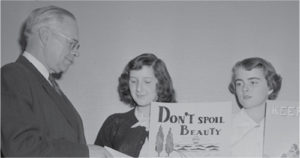 ▲ 1951
▲ 1951
Chamber president Benjamin Atwood promotes “Keep Cape Cod Clean” campaigns and calls for “Trash Slingers” fine.
1950
Chamber relocates to a new building at the rotary at Route 6, West Barnstable. Nine years later, Exit 6 would be installed. In 2021, the exit is renumbered to 68.
1964
Chamber advocates for a Cape Cod Planning and Economic Development Commission in county government to “preserve the character of Cape Cod.” Chamber executive Norman H. Cook becomes first executive director of CCPEDC (forerunner of today’s Cape Cod Commission).
1970
Michael Frucci becomes executive secretary.
1980s
Cape Cod experiences unprecedented growth of residential and commercial properties.
1990
CCPEDC becomes the Cape Cod Commission with regulatory power over land use.

1995
Route 25 Visitor Center, located 3 miles from the Bourne Bridge, opens. Former Sagamore Bridge info booth donated to Bourne Historical Society. It’s now on the grounds of Aptucxet Trading Post.
1997
Frucci retires, Wendy Northcross named interim executive director.
1998
Northcross appointed to Community Working Group, which releases consensus land use planning for Mass. Military Reservation (now Joint Base Cape Cod).
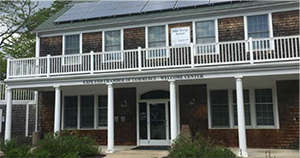 ▲ 1998
▲ 1998
Chamber merges with county’s Cape Cod Economic Development Council. John D. O’Brien becomes CEO and offices move to 307 Main Street, Hyannis (in a portion of the former Cape Cod Bank & Trust building).
 ▲ 2003
▲ 2003
Chamber returns to its renovated and expanded building near Exit 6 and constructs a new visitor center at same site.
2005
Chamber pushes workforce skills, creative economy effort, renewable energy, wastewater and transportation in addition to tourism promotion in its annual action plan.
2009
Chamber advocates for new canal area bridges and road/pedestrian access after maintenance work causes unprecedented backups and delays. 
▲ 2009
Annual Quahog Day launched on the first day of summer, to promote the number of beach days ahead.
2010
On Feb. 26, Patti Page Way is named after the artist who made famous the song “Olde Cape Cod.”
2012
In March, the board of directors voted to create the Wastewater Task Force, over concerns about pending lawsuits potentially forcing an overpriced and “under-scienced” solution on Cape Cod.
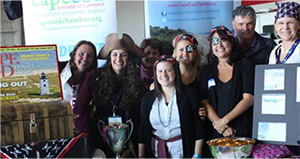
▲ 2013
Back to Business Bash features a pirate theme for the chamber’s networking presence.

▲ 2015
New Sandy Neck Conference Room opens. Chamber crew travels to Beacon Hill for State House Day to promote tourism.
2015
The Blue Economy Project is launched alongside a Creative Economy Initiative including public art installations.
2017
Annual public policy briefings with elected officials take place.
2018
Chamber wastewater task force and Cape legislators craft and pass law for Cape Cod & Islands Water Protection Trust Fund to build wastewater systems. and alleviate tax burden on residents.
2019
First grants totaling $71 million dollars flow to Cape towns from the Water Protection Trust Fund, saving property tax payers the same.
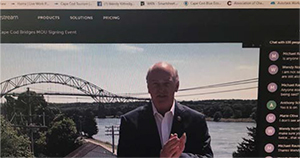
▲ 2020
In a virtual ceremony, Gov. Baker, Mass DOT and the U.S. Army Corps of Engineers agree to build/ maintain new canal bridges and adjacent ways for bikes/pedestrians/vehicular roads. Federal infrastructure funds are the last piece of the puzzle.
2020
Chamber helps form and facilitate a regional COVID-19 Response Task Force – navigating 15 months of the public health crisis causing business closures and restrictions. Task Force touted as a model of collaboration.

▲ 2021
The Blue Economy Project constructs Expedition Blue – 10 waypoints in towns across the Cape and Islands showcasing the Cape’s special connection to the water, from both social and economic perspectives. In June, the federal INVEST in America Act includes language that allows new bridges to be considered for funding passes in the U.S. House.

▲ Chamber Executive Director Wendy Northcross named Mercy Otis Warren Cape Cod Woman of the Year. Northcross retires after 24 years at the chamber and Paul Niedzwiecki, former executive of the Cape Cod Commission, is selected as next CEO as of July 1.

 The Cooperative Bank of Cape Cod is an independent, local, mutual community bank with more than $1.2 billion in assets and 170 employees. Founded in 1921, the bank has grown to include nine branches. In 2017 the bank named its first female president. “This is an exciting milestone as it not only underscores our resiliency, but also signifies what The Coop has meant to generations of Cape Codders,” said Lisa Oliver, chair, president and CEO. “We are and always will be a community bank. Together we have met challenges and experienced successes. We have helped build homes, rallied behind small business owners, supported clients from their first savings account all the way to retirement, and all while supporting nonprofit organizations across the Cape.”
The Cooperative Bank of Cape Cod is an independent, local, mutual community bank with more than $1.2 billion in assets and 170 employees. Founded in 1921, the bank has grown to include nine branches. In 2017 the bank named its first female president. “This is an exciting milestone as it not only underscores our resiliency, but also signifies what The Coop has meant to generations of Cape Codders,” said Lisa Oliver, chair, president and CEO. “We are and always will be a community bank. Together we have met challenges and experienced successes. We have helped build homes, rallied behind small business owners, supported clients from their first savings account all the way to retirement, and all while supporting nonprofit organizations across the Cape.”
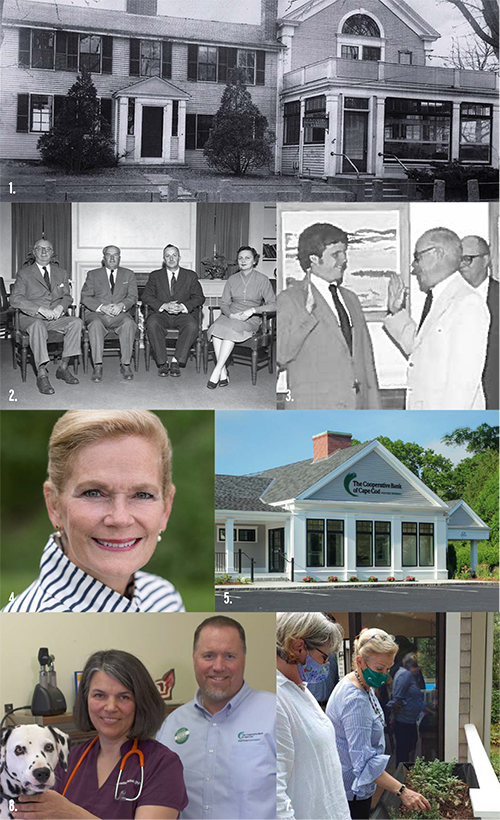
1. From 1921 to 1949, the Bank (then known as the Cape Cod Cooperative Bank), operated from the First National Bank of Yarmouth building in Yarmouth Port. In 1948, construction began for two buildings: one for The Coop and one for the First National Bank. Both opened in 1949 in Yarmouth Port, and the old building was demolished. 2. F. Howard Hinckley, first bank president, from left; Roswell H. Nye, second bank president; Nye Crowell, third bank president; and Harriett G. Chase, first female bank officer and board member. The photo was taken in 1956 at the Yarmouth Port branch. 3. Chair of the Board, President and CEO Joel Crowell is sworn in as the bank’s third president in 1983. Crowell served as president until his retirement in 2017. 4. Lisa J. Oliver, current and first female president. 5. The Bank’s oldest full-service branch is at 121 Route 6A in Yarmouth Port. It was remodeled in 2012. 6. Dr. Annette Herbst of All Pets Medical Center in Buzzards Bay stands with Rob Gillis, Vice President, Branch Manager – Small Business Specialist in Falmouth. The Bank helped Herbst expand her business with a line of credit in 2020 and also navigate the Paycheck Protection Program. 7. Lisa Oliver, right, checks out the newly planted flowers in October 2020 at the ribbon cutting for Cape Abilities’ Adopt-A-Home program. The Cooperative Bank of Cape Cod Charitable Foundation Trust (The Coop Foundation) is the inaugural sponsor of the program.
1921
April: Bank conceived by many of the people who worked for the First National Bank of Yarmouth. When that commercial bank reached its maximum statutory limit to issue residential loans, it formed the cooperative bank. July: Chartered as Cape Cod Cooperative Bank. Bank opens inside First National Bank in Yarmouth Port with F. Howard Hinckley named president.
1948
Construction begins on Cape Cod Cooperative Bank in Yarmouth Port. “Architect Walter M. Gaffney has designed the two buildings to be in keeping with the character and beauty of the village, and to conform to Cape architecture in general. … The contract was awarded to John Lebel of Osterville. … Construction to end in May.” (Yarmouth Register)
1949
June: Yarmouth Port branch opens; assets reported at $2.5 million.
1951
November: Harriett G. Chase of Hyannis named assistant treasurer.
1956
F. Howard Hinckley retires; Roswell H. Nye becomes president.
1961
Roswell H. Nye steps down as president; Nye Crowell named president.
1966
East Dennis branch opens at 1591 Main St. (6A).
1981
West Barnstable branch opens at 1121 Route 6A.
1983
Nye Crowell retires; Joel Crowell named president.

1997
Bank expands to offer commercial banking services. Andy Eldridge named first Commercial Relationship Manager.
1998
Sandwich branch opens at at 275 Cotuit Road.
2002
Hyannis branch opens at 695 Attucks Lane.
2006
A 37,000-square-foot operations and administration building is constructed at 25 Benjamin Franklin Way, Hyannis.
2007
East Harwich branch opens at 1470 Orleans Road.
2009
#CharityJeansDay launches. The program, coordinated by the CCCB Employee Involvement Committee, allows employees to wear denim to work on payday Fridays for a monetary contribution. The funds are collected and dispersed to employee-selected Cape Cod charitable organizations.
2010
Bank launches Stuff-a-Stocking campaign, collecting new, unwrapped toys at all branches to donate to the Boys and Girls Club.
2011
Bank rebrands to be called The Cooperative Bank of Cape Cod.
2012
Falmouth, 649 Main Street, Loan and Business Development office opens. Branches in Yarmouth Port and East Dennis renovated.
2013
Branches open in North Falmouth, 660 N. Falmouth Way, and Marstons Mills, 3878 Falmouth Road.
2016
Falmouth branch is relocated from 649 Main St. and opens at 238 Worcester Court as a fullservice branch.
2017
Joel Crowell retires; Lisa Oliver named president.
2018
Launched The Cooperative Bank of Cape Cod Charitable Foundation Trust, which allows the bank to significantly extend and increase the reach of its philanthropy. “We celebrated the Foundation’s debut in December by awarding $105,000 in one time and multi-year grants to four charitable organizations.” (Lisa Oliver).
2019
The Coop’s nine branches designate Tech Ambassadors, whose role is to assist customers with online and mobile banking. Customers can bring in their device − phone (Apple or Android), tablet, laptop − and Tech Ambassadors can work through any problems.
2020
February: Small Business Association names the bank an SBA Preferred Lender, a designation that allows The Coop to streamline loan decisions for small business clients. Bank surpasses $1 billion in assets. Begins renovation of headquarters at 25 Benjamin Franklin Way. Expected completion date
July 19, 2021.
Bank and Coop Foundation distribute more than $500,000, including Pandemic Relief Grants to 24 local organizations.
NOTABLE
First Woman Officer & Board Member:
Harriett G. Chase
Harriett G. Chase started with the bank in 1949 as a teller. She was appointed assistant treasurer in 1951, treasurer in 1961, and assistant vice president in 1974. Chase was also appointed clerk of the corporation in April 1961, and elected to the board of Directors in April 1976. She retired from the Bank in 1976. Chase graduated from Barnstable High School and Vesper George Art School of Boston. She was an art teacher at the high school until she was given a leave of absence to serve with the American Red Cross during World War II. She served in hospitals in England, France and Germany. She was active in several nonprofit organizations, including Cape Cod Hospital Aid Association, Hyannis Public Library, Beach Club. Chase died in 2001 at age 90.
The Coop’s Five Presidents
1. F. Howard Hinckley: 1921-1956 Frank Howard Hinckley was an incorporator and first president of the Cape Cod Cooperative Bank. He also served as a director of the First National Bank of Yarmouth. When he took the office in 1921, the bank’s assets were $1,611. When he retired in 1956, the assets were $4.5 million.
2. Roswell Howard Nye: 1956-61 Roswell H. Nye was a director for 35 years, served on the security committee for 25 years, and served as president for five years. Roswell H. Nye is of the Nye family in Sandwich and served as president of the Nye Family Association. https://www.nyemuseum.org/learn-more/nye family-association/
3. Nye Crowell: 1961-83 Nye Crowell started as a clerk with the bank in 1946. He was named treasurer in 1950 and became a director in 1955.
4. Joel G. Crowell: 1983-2017 Joel Crowell, the nephew of Nye Crowell, started with the bank in 1969 at its East Dennis branch. He served as treasurer from 1976-83. The bank’s assets in 1983 were $69.5 million and grew to $850 million in 2017. Crowell Oversaw the bank’s expansion of locations (East Harwich, Falmouth, Marstons Mills, North Falmouth, and Sandwich) and also oversaw the bank’s expansion into commercial lending in 1997.
5. Lisa J. Oliver: 2017-present Prior to leading The Coop, Lisa Oliver spent 25 years at Cleveland, Ohio-based KeyBank where she rose quickly and assumed several senior leadership roles. Before relocating back to the Northeast, she was the Executive Vice President and Head of Business Banking, leading the company’s $3 billion business unit. Early in her career, she led business banking teams across Maine, Vermont, New Hampshire, and New York as the Northeast Sales Executive. After moving to Cleveland, Oliver served as the president of the Northeast Ohio Region for 13 years leading the retail, commercial, business, and private banking sales teams.
BUSINESS TOOLBOX
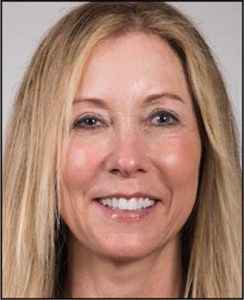 By Jacqueline Nolan
By Jacqueline Nolan
Fraud and cybersecurity should be a major concern for each and every business owner. According to the latest AFP Payments Fraud and Control Survey, 62 percent of companies experienced attempted or actual payments fraud from business email compromise (BEC) in 2020, and 34 percent reported financial losses as a result. The recent COVID-19 pandemic exaggerated these statistics, as the continued remote work conditions have unfortunately opened the door to an increased risk of fraud. The good news is that there are a number of best practices for protecting your business assets. Below are some tools and tips that our Treasury Management team recommends to stay ahead of the risk.
1. Employees are your front line of defense.
Preparation is the key to success. Business owners should invest in ongoing virtual training to ensure employees are upto-date on the latest policies and procedures. Important Note: You’ve likely adjusted how your organization operates in light of COVID-19. Despite these changes and the stress they can cause, encourage employees to take breaks to keep themselves fresh and alert, so that protocols (even while working from home) are always at the forefront of everyone’s minds.
2. Stay up-to-date.
Fraudsters sometimes use the names of real organizations, like the Small Business Administration (SBA) in their phishing attempts to add a layer of credibility. Staying on top of these evolving schemes, and vigilantly educating your employees on them, is one just one other way to protect your business.
Important Note: Phishing attempts often impersonate C-suite level employees, requesting immediate payment or other financial transactions to defraud your organization of funds.
Not sure where to start?
“The recent COVID-19 pandemic exaggerated these statistics, as the continued remote work conditions have unfortunately opened the door to an increased risk of fraud. The good news is that there are a number of best practices for protecting your business assets.”
Here are a few other tips I recommend to my own business customers:
- Traditional payment methods such as checks should have dual controls in place to reduce the risk of any internal fraud
- Payment apps like Square, CashApp or Venmo require verifying details like the recipient and amount is critical
- All invoices should be carefully reviewed to ensure that nefarious attackers did not interfere
- Implement fraud detecting banking tools:
Automated Clearing House (ACH) or Positive Pay, which protects your account from unauthorized check and incoming ACH transactions Reconciliation detects potential fraud, and if acted upon within 24 hours of an incident, dramatically increases the chances of recovering your money - Create text and email alerts to stay on top of your business’s accounts and financial activity
The bottom line: Fraud is an ongoing battle that your business must be prepared for. Unfortunately, it is not so much a question of if attempted fraud will happen, but when. There are many steps business owners can take however to detect payments fraud (and stop it) early.
Jacqueline Nolan is vice president of Treasury Management at Rockland Trust. She can be reached at 508-732-3362 or Jacqueline.Nolan@ RocklandTrust.com
To learn more, download the free Rockland Trust Fraud Prevention Checklist: https://bit.ly/3hjoNhs
BUSINESS TOOLBOX
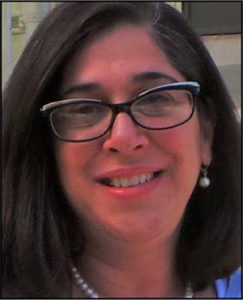 By Leah LaCross
By Leah LaCross
As we begin to see the light at the end of the pandemic, we are beginning to realize just how transformational the last year has been. And it’s not just organizations or business owners that have experienced a massive transformation. Employees have too, and their expectations from their employer are now higher than ever. They are more selective, and only want to work for companies that realize their worth and prioritize their needs and well-being. They want a positive “employee experience.” “The employee experience is the journey an employee takes with your organization,” according to Gallup, the global analytics and advice firm that helps leaders and organizations solve their most pressing problems.
“When they do start, ensure that their onboarding and training experience is organized, comprehensive, and efficient.”
In other words, how are employees experiencing their own workplace? Employee experience is the total of every interaction an employee has with your organization. It starts at recruitment, moves to onboarding, training, and then every other experience that happens up until the day that they leave. It includes everything from work anniversaries, personal relationships with their co-workers, to the ease and effectiveness of the technology they use and their physical work environment. Leadership has an opportunity to have touchpoints with their employee at each of these stages of employment to make it a good experience, and no component of the employment is more or less important than the other. For instance, I have a client who is a c-suite executive in a mid-size corporation. She loves her job but almost worked for a competitor instead. The competitor had gone out of their way to recruit her, but after the first interview, communication dropped off. “I was very confused,” she said. “My interview went so well, and it seemed like our values were completely aligned. Then, nothing.” But they did call her back. Two months later. They apologized for the delay and told her that she was the front-runner, but they had been distracted by other priorities at the organization. They now were ready to schedule the second interview. But it was too late. The recruiting experience had left a sour taste in her mouth. “I was already frustrated and discouraged and I hadn’t even started. If someone had just reached out to me in those two months, I would have been more understanding,” she added. “Having no communication gave me a glimpse of what it must be like to work for that company. I was no longer interested.” So, how do you ensure you’re providing a positive employee experience? The most important thing you can do is keep the lines of communication wide open. Welcome your new employees before they even start. Make them excited to come work for you. When they do start, ensure that their onboarding and training experience is organized, comprehensive, and efficient. After two or three months, meet with them (or all of your new employees) and ask for their feedback. What has been great about their experience since they started? What needs improvement? If they offer good suggestions, implement them as soon as possible. Celebrate work anniversaries and publicly praise their accomplishments whenever possible. Also, create opportunities for your employees to connect beyond the annual holiday party, and facilitate the formation of their own community. Company sports teams, retreats, after-hours gatherings will all help bring your teams together. The companies that get the employee experience right are the ones that will build a competitive advantage and differentiate themselves from the rest of the companies trying to attract and retain A-plus talent. It takes a little more attention and effort, but the benefits are worth far more than the time investment it takes to make your employees happy at work.
Leah LaCross is founder of Scargo Consulting,
based in Dennis. She can be contacted at llacross@scargoconsulting.com
LAST WORD

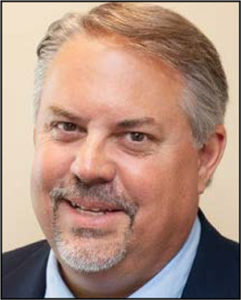 By Matt Pitta
By Matt Pitta
When the COVID-19 pandemic hit in March 2020, it quickly became clear that people would need assistance as countless jobs were cut back or eliminated. In those early days of the outbreak, it was the correct policy to help people who lost their livelihoods through no fault of their own. When the government ordered businesses to close, it was necessary to provide a lifeline to those owners and employees who were left with no options. But as the pandemic has greatly eased with the widespread availability of vaccines and declining infection numbers, businesses are roaring back to life with the prospect for one of the biggest economic summers on record for Cape Cod. That has resulted in a desperate need for labor, even beyond the normal challenges all Cape Cod businesses have during their peak hiring season. Unfortunately, the ongoing policies that include federal wage subsidies of $300/week and a state unemployment compensation package that is one of the most generous in the nation have created an unprecedented disincentive to work in Massachusetts. At a time when Cape Cod businesses are ready to rebound from the most devastating economic hit in their history, they now face an equally ominous future as it has become nearly impossible to staff their companies with the labor needed to operate and serve the upcoming summer demand. There is no debate that the current federal and state unemployment/pandemic relief plans are the number one reason businesses are unable to hire. Prospective employees have told many employers that they have no incentive to return to work and can “earn” more money staying on unemployment. The main competitor in securing critical labor for Cape Cod businesses has become the state and federal government – not other restaurants, hotels, and retailers, etc. Consider this: According to Forbes Magazine’s online stimulus calculator, the average weekly unemployment benefit in Massachusetts is $471. Combine that with the extra $300 a week being paid through September and the average weekly wage for a person collecting all available benefits is $771 per week, or $3,084 a month. That translates into $19.27 per hour. The state and federal governments are arguably paying some people nearly $20 an hour not to work, when there are thousands of jobs going unfilled. As additional evidence of what has become a disincentive for people to work, consider the current unemployment rates. According to numbers released by the Massachusetts Executive Office of Labor and Workforce Development, the Cape & Islands region unemployment rate was 6.6 percent in May, higher than the state average of 6.1 percent. And the Cape Cod rate was tied withBristol County for the fifth highest jobless rate in the state. The disconnect is clear. Barnstable County still has a comparatively high unemployment rate, but employers still report a record number of job vacancies they are unable to fill. While other factors are in play when it comes to the Cape’s labor crisis, such as a need for housing, the undeniable main factor is the amount of stimulus money people continue to be paid. People who already live on Cape Cod and don’t need seasonal housing are staying out of the workforce. In the early days of the pandemic, assistance from the government was a life-saving necessity that allowed families to keep food on the table. In the summer of 2021, that amount of “free money” being handed out has created one of the biggest disincentives to work modern society has ever seen. It’s time for the government to stop creating an environment where there is no reason to return to work.



